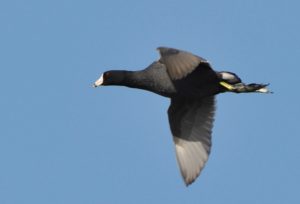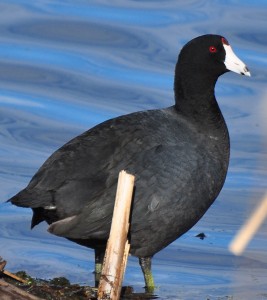Photography courtesy of Lowell Washburn, all rights reserved.
COOTS ARE COOL
Commonly referred to as ‘mud hen or mud duck‘, the American coot is neither a duck nor a hen but is actually a giant member of the rail family. During fall, coots congregate in large rafts that contain hundreds, even thousands, of birds. Coots obtain the majority of their food by diving to the bottom of open lakes and marshes where — instead of mud – they seek and devour the tender roots, shoots, and seeds of aquatic plants.
When it comes time to leave the water, coots require a long running takeoff. Once airborne, their flight appears weak and clumsy. But mud hens are capable of conducting strong, long distance migrations that may stretch from central Canada to as far south as northern South America. But coot migration occurs at night and, in spite of their incredible abundance, most people will never see the flight. Taking wing at sunset and flying through the night, the birds arrive at their destinations enmass. At daybreak, local duck hunters are often surprised to find their favorite wetlands dotted by hundreds of coots where few or none were present the day before.
In 55 years of duck hunting, I’ve only witnessed coot migration on two occasions. One was at Winnebago county’s Rice Lake; the other at Ventura Marsh in Cerro Gordo county. Both occurred during the first week of November. Both events were shared by long time hunting and trapping partner, Ed Kotz.
The migrations had other similarities. Both were spectacular mass exoduses that occurred under clear, mostly calm skies. The flights began at sunset when large numbers of coots suddenly began taking to the air. This time, instead of appearing weak or clumsy, their flight was light and buoyant. Upon rising from the water, each coot would begin spiraling upward in wide circles. The birds circled higher and higher until becoming mere specks in the binoculars. Reaching their desired altitude, the birds leveled off and disappeared to the south. As daylight diminished, more and more birds joined the exodus until the scene resembled a giant rotating swarm of insects or perhaps a ‘coot tornado’. Although the flight appeared random and disorganized, all birds ended up at the same altitude, traveling in the same direction with birds forming a continuous north/south line that must have stretched for miles.
Firsthand opportunities for viewing a coot migration are apparently so rare that I’ve only heard one other person describe it. The migration occurred at southeast Iowa’s Lake Odessa, where DNR Wildlife Supervisor, Bill Ohde and son Nick had just finished a late afternoon duck hunt. Ohde’s description of the event was a carbon copy of what Ed Kotz and I had observed farther north in Cerro Gordo and Winnebago counties.
LW



 Tom Cope
Tom Cope Sue Wilkinson
Sue Wilkinson Susan Judkins Josten
Susan Judkins Josten Rudi Roeslein
Rudi Roeslein Elyssa McFarland
Elyssa McFarland Mark Langgin
Mark Langgin Adam Janke
Adam Janke Joe Henry
Joe Henry Kristin Ashenbrenner
Kristin Ashenbrenner Joe Wilkinson
Joe Wilkinson Dr. Tammy Mildenstein
Dr. Tammy Mildenstein Sean McMahon
Sean McMahon